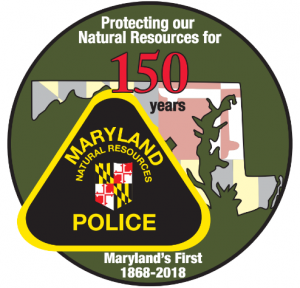Oldest State Law Enforcement Agency Turns 150 Next Year
 March 30, 2017, marks the 149th anniversary of the Maryland Natural Resources Police, the oldest state police force and the nation’s fifth-oldest conservation law enforcement agency.
March 30, 2017, marks the 149th anniversary of the Maryland Natural Resources Police, the oldest state police force and the nation’s fifth-oldest conservation law enforcement agency.
The day is being marked with the unveiling of the 150th anniversary badge, which may be worn by officers next year, and a “Maryland’s First” commemorative logo, which will soon adorn agency offices, vehicles and vessels.
“Natural Resources Police has a long and proud history of protecting the state’s natural resources and watching over citizens and visitors,” Superintendent Col. Robert K. “Ken” Ziegler Jr said. “Every day officers prove that our core values of professionalism, dedication, integrity and courtesy are more than just words on paper.”
The 150th anniversary celebration next year will include a public open house, a historical publication and localized events tied to the agency’s offices. A cannon used during the earliest days of Natural Resources Police enforcement efforts, will be used in educational programs at area schools.
“From the mountains of Western Maryland to the waters of the Chesapeake Bay, the men and women of the Natural Resources Police play a pivotal role in protecting our state’s treasured natural resources for this and future generations,” Maryland Natural Resources Secretary Mark Belton said. “The ‘thin green line’ is indispensable to the department’s conservation-minded mission and vision.”
Created by the General Assembly March 30, 1868, the State Oyster Police was charged with regulating the oyster industry and bringing order to the often lawless Chesapeake Bay, where pirates stole both oysters and goods. Hunter Davidson, a Naval Academy graduate and Civil War veteran, was named the first commander.
In 1896, the legislature created the Office of the State Game Warden, led by Robert H. Gilbert of Baltimore. After decades of name changes and configurations, the fish, game and boating enforcement efforts were consolidated in 1971 under the name, the Maryland Natural Resources Police.
Today, the police force, an authorized strength of 262 officers, is responsible for patrolling 470,000 acres of public lands, the Maryland portion of the Chesapeake Bay and its tributaries, the Atlantic Ocean coast and coastal bays and 9,000 miles of freshwater rivers and streams. Natural Resources Police aids boaters in distress, locates lost hikers and hunters and provides boating and hunting safety education.
Officers inspect fish that are shipped through Baltimore/Washington International Thurgood Marshall Airport, Jessup Wholesale Center and Ocean City commercial piers. They inspect Maryland-caught oysters, crabs and fish.
The force has been designated Maryland’s lead agency for maritime homeland security, charged with protecting 18 locations designated by the U.S. Department of Homeland Security and nine additional sites identified by the state.


